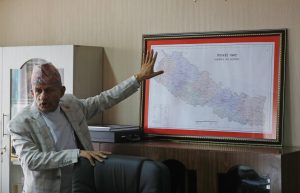On May 12, the economic adviser to the president of Nepal, Chiranjivi Nepal, resigned following his criticism of the government’s decision to print a contentious map showing disputed territories with India on new hundred-rupee notes. The government deemed his remarks damaging to the national interest, which led to his resignation.
The map issue has reignited the territorial disputes with India.
In 2020, the government of Nepal introduced a new map delineating areas contested with India – Kalapani, Lipulekh, and Limpiyadhura – as its own, despite the ongoing talks through established diplomatic channels. Kathmandu was apparently responding to India’s construction of a new road in the disputed region. Nepal’s Parliament unanimously formalized the government’s new map through a constitutional amendment in June 2020.
The present ruling left-alliance government in Nepal – led by Prime Minister Pushpa Kamal Dahal, alias Prachanda, of the Communist Party of Nepal-Maoist Center – has projected the printing of the controversial map as a nationalistic move asserting the country’s territorial sovereignty and integrity. But that’s not the only reason behind the inclusion of the map on Nepali currency.
The Janta Samajbadi Party, one of the key coalition partners in the left-alliance government, had been hinting at withdrawing support and finally did so on May 13. Amid this, Dahal will face a floor test to prove his majority in the Parliament on May 20. This will be the fourth time Prachanda will face a floor test since his appointment in December 2022.
Dahal needs the full support of his coalition partner, the Communist Party of Nepal-Unified Marxist-Leninsit (CPN-UML), to save his government. Former Prime Minister K.P. Sharma Oli’s CPN-UML has been unpredictable and often withdrawn its support at the last minute. Putting the controversial map on new currency notes satisfies the CPN-UML, as it was during the Oli-led government in 2020 that Nepal amended the map and constitution.
The CPN-UML has been the flag-bearer of the anti-India movement in Nepal. During the constitutional crisis, followed by a border blockade with India in 2015, and then the map issue in 2020, the CPN-UML was instrumental in social media trends like #BackOffIndia and #GoBackIndia. By reigniting the territorial debate against India, Dahal is, in a way, attempting to showcase his loyalties to the CPN-UML to ensure that his government has their support.
Meanwhile, India has responded to Nepal’s decision to put the controversial map on the new notes. India’s Minister of External Affairs S. Jaishankar stated, “We were having discussions about our boundary matters through an established platform. And then in the middle of that, they [Nepal] unilaterally took some measures on their side.”
India’s MEA spokesperson reiterated Jaishankar’s remarks on the matter while addressing the media.
The MEA spokesperson also emphasized that “by doing something on their [Nepal’s] side, they are not going to change the situation between us [India and Nepal] on the ground.”
India has been clear in maintaining that Kalapani, Lipulekh, and Limpiyadhura are integral parts of India. These territories are currently under Indian control and hold strategic significance. With India and China vying for influence in the greater Himalayas, the likelihood of India giving up any such territories is slim.
The border dispute gained prominence after Nepal objected to a new Indian map in October 2019. India released the new map following the abrogation of Article 370 in the constitution, which granted special status to Jammu and Kashmir, and the creation of the new Union Territory of Ladakh from the former state of J&K. Nepal complained that India had wrongly depicted Kalapani, Lipulekh, and Limpiyadhura in its map.
By June 2020, Nepal had countered with its own official map exerting its claim to the territories. New Delhi responded by stating that “the new map in no manner revised our boundary with Nepal.”
Interestingly, many in India are quick to see a Chinese angle to Nepal’s latest move, particularly when Nepal’s left parties are strengthening their ideological bond with the Chinese Communist Party (CCP). In April, Deputy Prime Minister and Foreign Minister Narayan Kaji Shrestha chose China for his first foreign visit.
While speculations are high that the decision to include the map on Nepal’s 100 rupee notes was influenced by Shrestha’s visit to China, there is little to prove it.
Meanwhile, printing a controversial map on currency underscores Nepal’s lack of diplomatic foresight in maintaining stable relations with India. This could potentially strain the historical ties and mutual trust between the two nations, further complicating regional dynamics. By putting the map on 100 rupee notes, Nepal has narrowed the possibility of resolving the issue with India on two grounds.
One, by incorporating the disputed territories into the design of its currency, Nepal is symbolically entrenching its position on the border issue. This solidifies Nepal’s stance that these territories are its own, and it will be challenging for Kathmandu to negotiate on its claims in the future. Any attempt to reach a resolution with India would require Nepal to backtrack on its public stance, which could be seen as a loss of face domestically and weaken the government’s credibility (especially for the leftist parties currently in power).
Two, if a diplomatic agreement is eventually reached between New Delhi and Kathmandu, it would likely involve redrawing boundaries or revising territorial claims. However, the presence of the disputed territories on the currency means that Nepal would need to recall and replace all the newly issued notes, which can be a costly and logistical challenge.
Moreover, amending Nepal’s constitution to remove references to the disputed territories would require political consensus, which may be difficult to achieve, especially if the issue has become deeply entrenched in Nepal’s political discourse.
In conclusion, maps and currencies represent the pinnacle of national identities, deeply rooted in patriotic sentiments. Placing disputed or controversial maps on bank notes necessitates thorough consideration from all diplomatic angles. While such moves may help the leftist coalition survive, they carry long-term implications for the country’s ties with India.
































